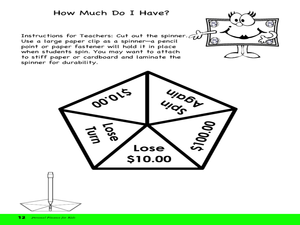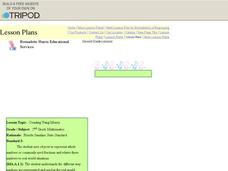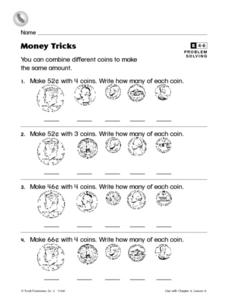West Contra Costa Unified School District
Interest and the Number e
Mary, Mary, quite continuously, how does your money grow? Uses examples to examine the difference between simple interest and compound interest, and to take a look at different rates of compounding. Learners explore what would happen as...
EngageNY
Mid-Module Assessment Task: Grade 8 Module 6
Make sure pupils have the skills to move on to the second half of the module with a mid-module assessment task. The formative assessment instrument checks student learning before moving on to the rest of the lessons in the unit.
Scholastic
Study Jams! Double-Line Graphs
With two summers of babysitting money, Mia needs a way to compare her earning from both years. Show your learners that they can organize the data onto a double-line graph to easily compare which summer was more profitable. The lesson...
Charleston School District
Converting Fractions and Decimals
A decimal is just a fraction in disguise! Scholars learn methods for converting decimals and fractions including repeating decimals. Performing the conversions strengthens their understanding of the relationship between the two forms....
Federal Reserve Bank
Creating a Budget
Learning to create and maintain a budget is an important life skill. Guide individuals in the discovery of their spending habits and how to track them. They then use what they learned to create a budget and make decisions on where they...
Yummy Math
Penny Wars
As the saying goes, a penny saved is a penny earned. Young scholars use a penny activity to earn their way to an understanding of volume. Given three different-sized cylindrical containers, individuals make calculations to determine the...
West Contra Costa Unified School District
Interest and the Number “e”
Make a connection between different types of interest and how they are calculated! This algebra II lesson progresses from simple interest to compound interest to continually compounded interest. Formulas are developed rather than given,...
CK-12 Foundation
Function Rules based on Graphs: Making Money in the Hat Business
Hats off to those learning about the graphs of functions. Individuals use an interactive to plot points representing profits for a hat business. They identify a quadratic equation to represent this function and answer challenge questions...
Curated OER
Piggin' out with Money
Third graders manage money. In this money math activity, 3rd graders read Pigs Will be Pigs. Students then use manipulatives to practice adding monetary amounts and making change. Students also practice working with money on selected...
Curated OER
Sea and Learn - Lesson Plan: Dockyard Maties
Learners solve word problems involving money using all four operations listed, and convert pre-decimal currency into decimal currency. They discuss how dockyard mates were paid and the equivalence with today's money, and complete a...
Curated OER
Wealth
Third graders read the story The Day I Was Rich and learn about the role of money and taxes. In this money lesson plan, 3rd graders count large sums of money, group them, and give it away in the form of taxes. They discuss wealth and how...
Curated OER
Money Math
Students explore a story about a room decoration activity to learn about measurements and area. In this measurement lesson, students listen to a story about a boy who is redecorating his bedroom. Students discuss the story and work in...
Curated OER
Lesson 3: Where Does Money Come From?
Students listen to story Hundred Penny Box by Sharon Bell Mathis, explore history of money, and examine how money is produced in the United States. They discuss why money is used for exchange, and describe how money has changed over time.
Curated OER
Let's Find Out About Money
First graders investigate the uses and development of money as part of the study of finance. They focus upon the recognition of different coins and identify the value of each. Then students solve problems involving money and coins.
Curated OER
Money Issued
Fourth graders explore economic issues. In this economics lesson, 4th graders read Alexander, Who Used to Be Rich Last Sunday and discuss how Alexander wasted his money. Students write about a time when they made a poor money decision.
Curated OER
Let's Find Out About Money
First graders identify coins (pennies, nickels, dimes and quarters), and their attributes, including physical characteristics and value.
Curated OER
Vocabulary Lesson: Money - Worksheet 5
In this money vocabulary worksheet, students fill in the blanks in 6 sentences using the word bank at the top of the page. They use words such as inherit, borrow, steal, waste, and withdraw.
Curated OER
Counting Using Money
Second graders count fake money by grouping like coins together. In this counting lesson plan, 2nd graders complete worksheets provided in this lesson plan.
Curated OER
Vocabulary lesson: Money Worksheet
In this money worksheet, learners match money vocabulary words to their definitions. Students complete 10 matches total on this worksheet.
Curated OER
Money: Demonstrating Coin Value up to $1.00
Students examine coin values up to $1.00 using paper coins. In this coin value lesson, students compare and contrast various coins to aid in identification, sort coins from smallest to largest, and match an equal number of pennies to...
Curated OER
Multiplying Money
Fourth graders use movie ticket prices and zoo admission prices to practice multiplying money amounts. In this money multiplication lesson, 4th graders use the Internet to find admission prices for amusement prices and movies. Students...
Curated OER
Money Banks
In this different coins worksheet, 1st graders guess which piggy bank has the most money in it. Then students count the actual amount of money in each piggy bank by counting and adding up the coins.
Curated OER
Money Tricks
In this money worksheet, 2nd graders practice combining 4 and 3 different coins to make 52 cents, make 46 cents with 4 coins and 66 cents with 4 coins.
Curated OER
Money Mystery
In this money worksheet, 2nd graders study and analyze 7 clues in order to complete a table on how many coins each child has in total value.
Other popular searches
- Money Math Lessons
- Counting Money Math Lessons
- Autism Money Math Lessons
- Shopping Money Math Lessons
- Math Lessons With Money
- Math Lessons on Money
- Money Math Lessons for Life

























